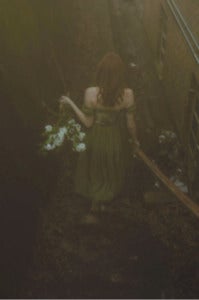By Zoe Fitch
There is a saying in the South that refers to a sunshower, “The Devil’s beatin’ his wife”. When this anomaly occurs it is usually during the time of day when the sun is at its highest position in the sky, and the rain falls when you least expect it. The lighting in the South is said to be like no other. At a certain time of day, the world is transitioning into night but the sun is not yet gone, a spiritual presence can be felt. A similar feeling, experienced in instances such as these, can be felt when critiquing Sierra Dexter’s photography.
Traditionally the South has held a reputation for being backward or underdeveloped yet spiritually advanced. While this argument is ongoing, the latter has proven true to an extent. But this concept is sometimes hard to conceive in all of its aspects. You see, spirituality does not necessarily refer to the bible-thumping barefoot people filled shacks seen in representations of the South in history books but something more universal. When your environment is still and you see what isn’t there reality is seen most clearly.
The term ‘Southern Gothic’ refers to a type of writing style employed by many writers from the American South that utilizes macabre, grotesque, ephemeral, and fantastical characters and situations, as well as a visual aesthetic used by fine artists. These narratives also criticize the region’s racism, sexism, classism, and the fall out of a decaying economy recorded in history. The tension between the grotesque and the beautiful fascinates artist Sierra Dexter. Characteristics of horror and beauty can be found in twilight lighting, abnormal settings and posing, allusions to the past seen in dilapidated buildings, and overgrowth of native flora. The pictures become symbols that mimic the past and inspire folklore. Forgotten sites, such as those seen in Dexter’s images, are a bridge between the past and present. Her work pays homage to regionalism as well as her subject’s lineage and connection to land. The visual agony and ecstasy of growing up in the South is captured by Dexter’s lens.
Spirituality inevitably is seen in lighting. When the sun begins to set and the insects begin to hum, when the humidity is seen in the air and smelled too, is the time of day in the South when you know you are seeing the same thing your ancestors saw; authentic nature.
Sierra Dexter is a contemporary photographer and fine artist from Memphis, Tennessee, though she has called Mississippi home for most of her life. She currently resides in Water Valley, MS, which is an old town with an upcoming and thriving art community. Though she might not have imagined her current career growing up, she recalls her grandmother supporting her craft and creativity most of all. Dexter has offered boudoir sessions and wedding photography when she is not working on passion projects.

Sierra Dexter, Down the Rabbit Hole, photograph
(At left, Sierra Dexter, Down the Rabbit Hole, photograph)
Dexter usually begins her process with open model calls and a mental note of a weird and funky location. She uses unique angles and editing to use chiaroscuro techniques and allude to a past time that still lingers in the region. Her fine art approach began from a business-minded aspect. Dexter claims she was called home after losing the openness that Mississippi offers to the Dallas, Texas city terrain during her time there. Much of her process and/or research starts with driving around rural areas finding old country roads that house old trees dying next to rotting, dilapidated buildings. These objects hold history in their fibers, and Sierra Dexter captures their stories with her keen eye behind the lens. Much of these found places are where Dexter and her family members have called home or have at least visited. In some ways she searches for her own history in the land in which she is from while capturing a new one that she curates.
Southern blues culture, horror and cinema, eerie southern history, and the beauty of the regional landscape inspires Sierra Dexter. She is inspired by the juxtaposition of beauty and horror, grotesque and wonderful. This balance can be seen in her work featuring traditionally attractive women with floral arrangements and/or fantastical poses in dark, sometimes foggy lighting. Dexter says she is inspired by the unique lighting in the region where you can “hear the sound of summer”. Like many creatives, Dexter is a night owl. She claims that at night, when all else is sleeping, she “comes to life” much like her photographs.
Sierra Dexter finds life in the dilapidated, life in death. And just as the rhetoric of the southern way of life has changed, the natural environment has too. Though change is uncontrollable, much stays the same. Remnants of the past are embedded in our environments. So next time when you find yourself still looking at the sunset when it has just gone down or when the Devil’s beatin’ his wife, remember history is always present in your view.







